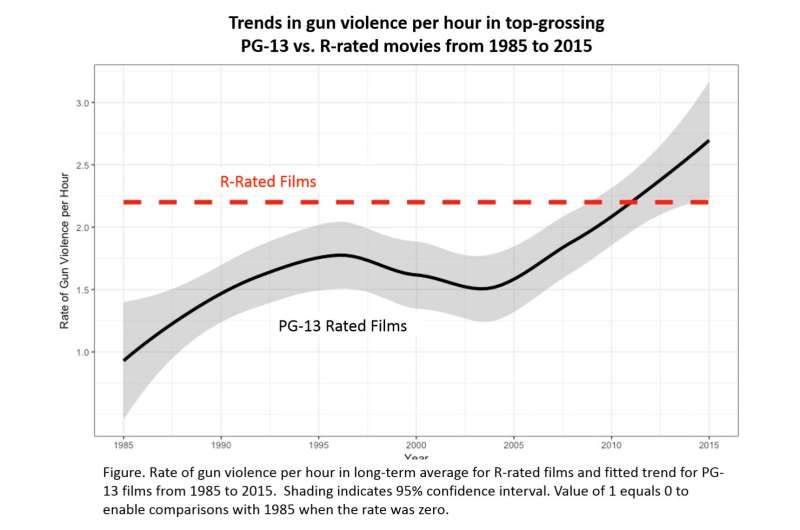PG-13 movies show more gun violence than R-rated films: study

(HealthDay)—The most popular PG-13 movies now depict more acts of gun violence than R-rated films, a new look at the U.S. motion picture landscape reveals.
The Motion Picture Association of America (MPAA) states that a movie rated PG-13 is open to all viewers, but parental guidance is suggested. An R rating means a movie can't be seen by minors under the age of 17 unless they are accompanied by an adult.
The new analysis updates an earlier 2012 investigation, which found that gun violence in the nation's top-grossing PG-13 films more than doubled between 1985 and 2012. By then, gun violence had begun to exceed that found in R-rated films.
Since 2012, the prevalence of gun violence in PG-13 movies—albeit less bloody and more cartoon-like than R-rated movies—held steady through 2015.
"There was no guarantee that the trend would continue, but that is what we found," said investigator Daniel Romer, research director at the University of Pennsylvania's Annenberg Public Policy Center.
That could pose a problem for children, suggested Scott Campbell, a professor of communication studies at the University of Michigan.
"Viewing violent media content has many negative effects, including desensitization, a distorted view of reality and aggressive behavior," he said. "[And] the trends uncovered in this study are concerning because young people are especially vulnerable to these effects."
For the study, Romer and his colleagues focused on a sample of PG-13 and R movies chosen from among the top 30 box-office performers each year between 1985 and 2015.
The team found that while about 30 percent of the top-30 films between 1985 and 1987 were PG-13, that figure rose to more than 50 percent by 2013-2015.
Over the same period, the number of R-rated films among the top 30 dropped from 40 percent to 23 percent.
To assess gun violence, the researchers divided each film into five-minute segments. Then they coded each segment to see if it included an instance in which one character fired a gun, striking another.
The researchers concluded that gun violence is now more prevalent in PG-13 films than in R films. But they also noted a difference: Gun violence in PG-13 films is more often driven by comic book characters and tends to depict fewer consequences, meaning less blood and suffering.
The researchers said more study is needed to determine if repeated exposure to gun violence—bloodless or otherwise—has a lasting impact on child behavior. But Romer said there's not much reason to expect a shift in the trend toward violence in PG-13 films.
"Given that these PG-13 movies with heavy doses of violence are very popular, it is difficult to see the industry changing its rules," he said. He added that "the MPAA would have to change its rating system to move these gun-violent movies into the R category, and it is unlikely they will do it without direct evidence that these films are having a negative influence on young people."

Romer noted that the film industry "did make some changes in response to the finding that smoking in movies was influencing some adolescents to start smoking. [But] we would need evidence like that to push them to make changes" to violent content.
Campbell, who wasn't involved with the research, suggested that one of the roadblocks to change is the MPAA's stance that "fantasy violence is OK because it isn't realistic.
"We'll see what the research says about that," he said. "But, studies do show that the lines demarcating fantasy and reality are less clear for younger viewers, which makes me suspect that the increasing amount of comic book-style killings may not be as benign as the industry proposes."
Chris Ortman is vice president of corporate communications at the MPAA. He defended the current film rating system. And he said the association's goal is to provide information so parents can come to their own decisions on family viewing choices.
"For almost 50 years, the Classification and Rating Administration (CARA), the voluntary film rating system administered by the MPAA, has provided parents with advance information about the content of movies to help them determine what is appropriate for their children, Ortman said. "This system has withstood the test of time because, as American parents' sensitivities change, so, too, does the rating system.
"Elements such as violence, language, drug use and sexuality are continually re-evaluated through surveys and focus groups to mirror contemporary concern and to better assist parents in making the right family viewing choices," he added.
Romer and his colleagues reported their findings online Jan. 11 in the journal Pediatrics.
More information: Daniel Romer et al, The Continuing Rise of Gun Violence in PG-13 Movies, 1985 to 2015, Pediatrics (2017). DOI: 10.1542/peds.2016-2891
There's more on teens and media exposure at American Academy of Pediatrics.
Copyright © 2017 HealthDay. All rights reserved.
















